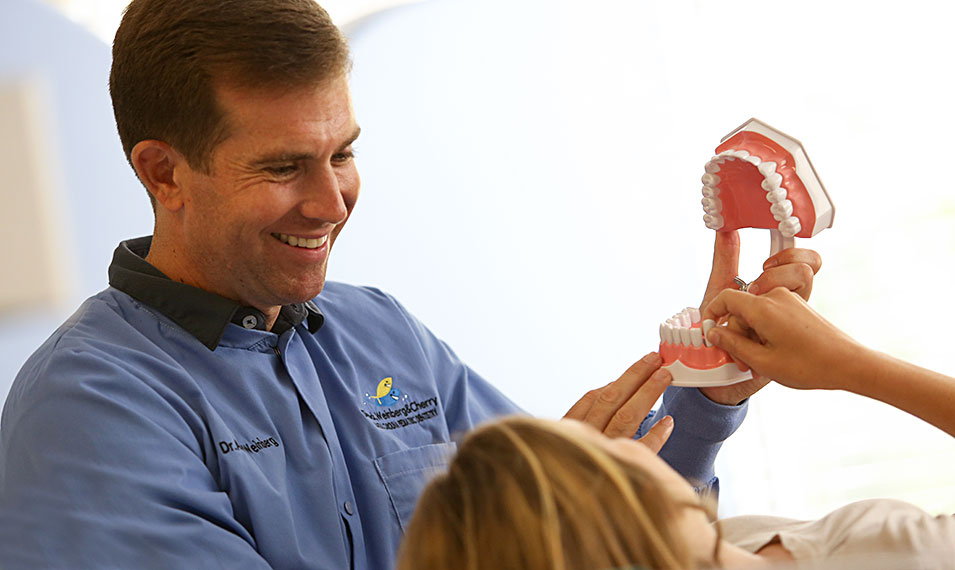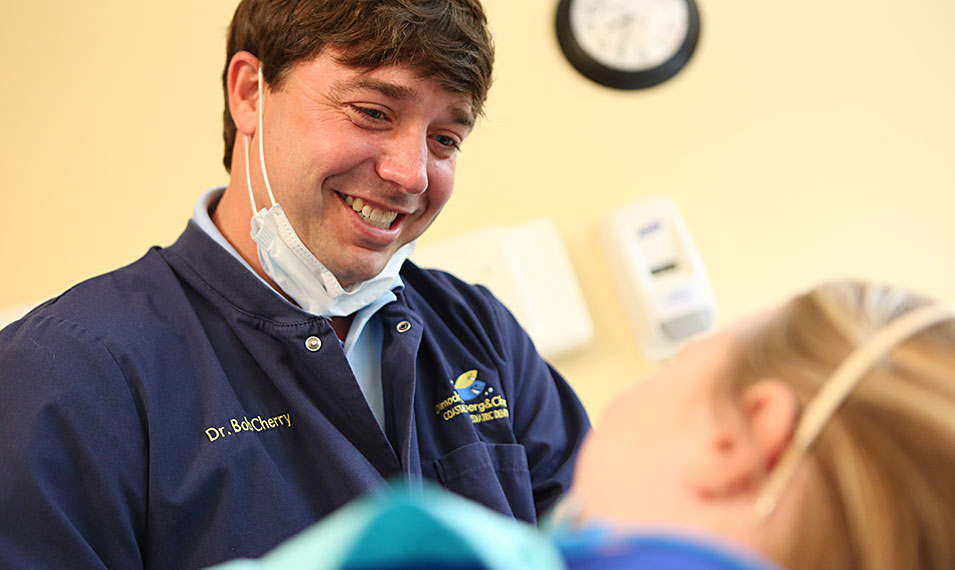
Infant Oral Exam

The American Academy of Pediatrics, the American Academy of Pediatric Dentistry and the American Dental Association all recommend that your baby visit the dentist by age 1. Getting an early start in regular dental care is an important step on the road to teaching your child healthy habits to last a lifetime. In addition to a “knee-to-knee exam” conducted while your child remains in your lap, at the first visit we will share with you the latest available methods for keeping your child healthy and safe. At this first visit we will present:
- A program of preventive home care including brushing, flossing, diet and the importance of fluorides.
- A caries (tooth decay) risk assessment.
- If age appropriate, information about Early Childhood Caries, which may be due to inappropriate nursing habits or inappropriate use of sippy cups.
- The latest facts about finger, thumb and pacifier habits.
- What you need to know about preventing injuries to the mouth and teeth.
- Information on growth and development.
Preventive Dentistry for Your Child

In an effort to prevent problems associated with teeth and the mouth, our office emphasizes preventive dentistry. We focus on oral hygiene, dental and oral development, fluoride, oral habits, orthodontics, parental involvement, proper diet, sealants, and/or sports safety. We use state-of-the-art digital radiography for immediate observation of x-rays and early diagnosis of potential dental problems. Preventive dentistry is important for your child because it can lead to long-lasting, happy smiles and great overall oral health. A beautiful smile is attractive and can give your child confidence in his or her appearance. Preventive dentistry can also mean less extensive – and less expensive – treatment for your child.
Restorative Care

Our restorative care includes tooth-colored fillings, nerve treatments, crowns, extractions and other services that repair your child’s teeth or address other oral diseases and conditions.
Behavior Management Methods

Every child is different, and each requires his or her own behavior management method to help them complete needed dental treatment. Behavior management techniques are used to help a child feel relaxed and confident, to guide a child in coping with dental treatment, and to complete dental treatment as efficiently and as safely as possible. We will recommend the best behavior management method(s) for your child based upon your child’s health history, special health needs, dental needs, type of treatment required, emotional and intellectual development and your parental preferences.
To be a well-informed parent, you should know the choices available to help your child during dental treatment. Working together, we will select the best treatment method(s) to make your child’s visit as safe and comfortable as possible.
- Tell-Show-Do: Our team explains the treatment in words appropriate for the child’s age and level of understanding shows the treatment in a simplified manner and then proceeds with treatment.
- Positive Reinforcement: The child is given praise for any behavior that helps with treatment. Every child does something right during a dental visit.
- Distraction: With this technique, our team will choose treatment words carefully, pass instruments out of the child’s sight and occasionally distract the child’s attention away from the treatment with conversation, overhead televisions, music or games.
- Nitrous Oxide/Oxygen: Sometimes, a child who feels anxious during treatment may need more support than a gentle, caring manner to feel comfortable. Nitrous oxide/oxygen is a safe, effective technique to help calm a child’s fear of the dental visit. It is nonaddictive, easily taken and quickly eliminated by the body. Your child remains fully conscious and maintains all their natural reflexes while breathing nitrous oxide/oxygen. While nitrous oxide/oxygen is not effective for some children, especially those who have severe anxiety, nasal congestion, extensive treatment needs, or discomfort wearing a nasal mask, it is a very useful tool in many situations.
- Conscious Sedation: This technique is beneficial for children with a very high level of anxiety preventing them from effectively coping with their fears in the dental environment, and for very young children who do not yet understand how to cope in a cooperative fashion. Conscious sedation is safe when administered by a trained pediatric dentist following the sedation guidelines of the American Academy of Pediatric Dentistry. Dr. Dimock, Dr. Weinberg and Dr. Cherry are BLS certified, PALS (Pediatric Advanced Life Support) certified and have extensive pediatric sedation training.
- General Anesthesia: Medically speaking, general anesthesia is an induced state of unconsciousness. In practical terms, the patient is asleep and unable to respond to touch or voices. It is most often recommended for very young children with extensive treatment needs and/or an inability to communicate and cooperate. It may also be the best way to provide treatment for children with special medical/developmental needs. All parents should know that children face the same risk under general anesthesia for dental treatment as for any other surgical procedure. When a general anesthetic is indicated, the dental work can be completed at New Hanover Regional Medical Center as an outpatient surgery in conjunction with a highly qualified anesthesiologist, certified registered nurse anesthetist and a team of nurses. Parents should talk openly with us about the benefits and risks of this option.
Interceptive Orthodontics

Our office provides interceptive orthodontics. This means we will monitor or head off any growth and development discrepancies that may impede the alignment or emergence of the primary or permanent teeth. Problems that can result in orthodontic treatment include thumbsucking, crossbites, overbites, protruding upper teeth, open bites and/or crowded teeth. As your child matures, we can help guide your child’s teeth with minor orthodontic corrections before they become a major concern.


